All About UGC Video Content: Ultimate Guide for Businesses & SMM
Discover what UGC content is and how to use it to boost trust, engagement, and sales, plus tips to create, repurpose, and manage it with AI Video Cut.

User-generated content (UGC) has moved from being a social media trend to a central part of marketing strategies. For businesses and social media managers, UGC video in particular is proving to be one of the most effective ways to reach audiences who are increasingly skeptical of polished ads. The absolute perk of a UGC video is that it’s created by your clients (so your team doesn’t put effort and resources into video creation), it’s free (sort of and not all the time but mostly), and it may convert better than those videos you’re creating in your team.
In this guide, we’re trying to explore what UGC video is, why it works, how brands can encourage it, and how to make the most of it with the right tools.
What Is UGC Content?
At its core, UGC video is content created by everyday users, not brands or professional production teams. You’ve seen such videos on social media: a customer recording themselves unboxing a product, a TikTok user showing how they style a clothing item, or a fan reviewing their favorite gadget on YouTube Shorts.
Unlike brand-created campaigns, UGC feels personal, raw, and relatable. It might lack cinematic lighting or scripted messaging, but that’s the point: it reflects real experiences.
Here are a few examples:
- A short clip of someone trying out a skincare product.
- A quick tutorial on how to use a new kitchen gadget.
- Participation in a viral TikTok challenge connected to a brand.
- Video testimonials shared on Instagram Stories.
The formats vary, but short-form video (under 60 seconds) tends to perform best on platforms like TikTok, Instagram Reels, and YouTube Shorts.
Who Is a UGC Creator?
A UGC creator is someone who produces photos, videos, reviews, or other types of content about a brand, product, or service without being part of the company’s official marketing team.
There are two main types of UGC creators:
- Everyday customers and fans
These are regular buyers who share their experiences online, often spontaneously.
Example: someone posts a TikTok showing how a new pair of sneakers fits or records a YouTube Shorts review of a phone case they just bought.
Their motivation is usually excitement, personal expression, or wanting to share recommendations with friends or followers.
- Professional UGC creators
These are freelancers or content creators who specialize in producing authentic-looking content for brands.
Unlike influencers, they don’t necessarily post the content on their own accounts. Instead, they create videos or photos that the brand can use in ads, on social media, or on websites.
Example: a UGC creator might be paid to record a casual “day-in-the-life” TikTok featuring a skincare product, which the company then runs as a paid ad.
Why UGC Content Works for Businesses & When It Becomes a Magic Pill
You’re Run Out of Content Ideas
When you don’t know what to post and your content plan seems empty, your clients help you fill those content gaps with their videos and give you new ideas, angles that you wouldn’t have thought about otherwise.
You’re Run Out of Resources
This one is a common struggle. If you’re not a corporation with endless budgets on content creation, you’ve probably faced something like "Why should I bother with making videos, I’ve got loads of other stuff to do." UGC is a solution for this, too.
Besides, you don’t have to pay for creating such videos which you do when working with influencers. No goods to be shipped, money to be spent, or license keys to be sent.
UGC Doesn’t Require Approval & Micromanagement
If that’s a common story in your team that a content / PR lead or CEO themselves micromanage and ask you to show every bit of the content for approval, UGC simply doesn’t need it: it’s not your company that creates this content, so it’s not your responsibility to approve it. You can just select the best UGC videos and those that feel more aligned with your brand values and reshare them on your social media.
Your Manager Is Toxic & Doesn’t See Your Content Works
Well, we’d suggest you should change your job but let’s keep it for another article. User-generated content is already a solid proof that your marketing or content strategy is efficient. If it wasn’t, your clients wouldn’t bother wasting their time on making content about your brand.
UGC Builds Trust
People are more likely to believe other people than brands. Nielsen’s consumer trust survey consistently shows that recommendations from peers carry more weight than advertising. A 15-second customer video saying “this actually worked for me” can often outperform a glossy commercial.
UGC Brings Higher Engagement
UGC is interactive by nature. Viewers comment, share, or create their own spin on the content. Brands that showcase customer-made videos often see stronger engagement than with traditional ads.
UGC Builds Communities
Inviting and sharing UGC signals that a brand values its customers’ voices. That sense of involvement builds loyalty and a stronger relationship between brand and audience.
The Best Platforms for UGC Content
If your brand isn’t there yet, it’s time to create an account on these:
TikTok
Known for viral trends and challenges, TikTok is the top platform for UGC video. Duets and stitches make it easy for users to add their own spin on existing content.
Instagram Reels
Instagram excels at lifestyle-focused UGC. Brands often reshare customer Reels showing how a product fits into daily life.
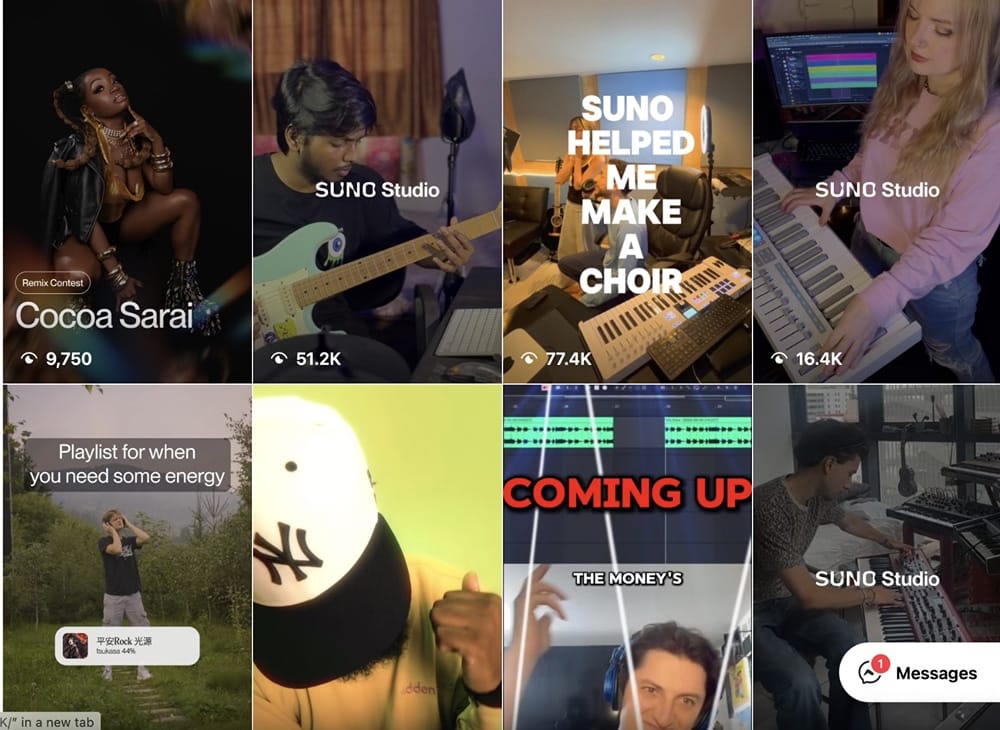
YouTube Shorts
UGC here often takes the form of reviews, tutorials, or “first impression” videos. These are especially powerful for products that need a little explaining.
Facebook & LinkedIn
Who said B2B brands couldn’t leverage the power of UGC? Though not as trendy, both platforms have their space. On Facebook, UGC often shows up in community groups, while on LinkedIn, customer case study videos can provide credibility in B2B marketing.
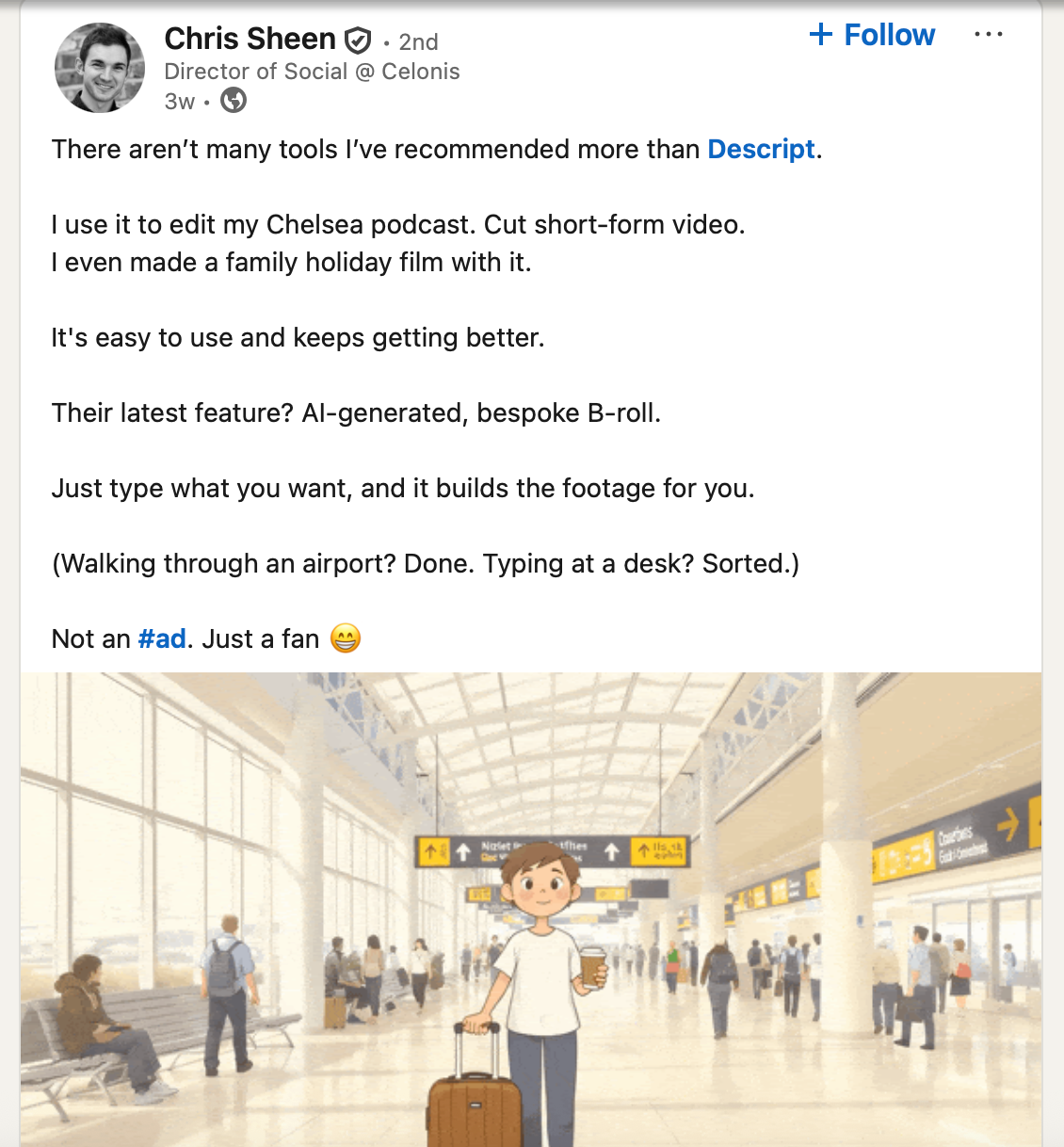
How to Encourage UGC Content from Customers (+ Examples of UGC Content)
This is probably the most challenging part of the whole UGC video content thing. Sure, if your brand is strong enough and your products are already popular, customers will create content about you without any incentives (think of thousands of videos featuring Figma, Notion or CapCup). After all, brand ambassadors do exist and their love for a brand might be strong and pure.
But not all businesses can always wait for content to appear on its own; here’s why a little bit of encouragement might help.
#1. Run Hashtag Challenges
One of the most effective ways to spark user-generated video content is through branded hashtag challenges. These work especially well on TikTok and Instagram, where trends spread quickly. A brand can create a unique hashtag and invite users to participate by posting their own videos under it.
An example of a brand that stimulates social media user-generated content with a hashtag is ASOS. Their campaign "#AsSeenOnMe" invites customers to post pictures wearing ASOS clothing with this hashtag. This campaign has been very successful; by this time, it has generated over 1.7 million uses of the hashtag across social platforms like Instagram, YouTube, and TikTok.
It encourages customers to showcase their unique styles and provides authentic social proof, boosting brand reach, engagement, and sales. ASOS benefitted from increased active consumers and higher average shopping cart values as a result of this hashtag-driven UGC campaign.
#2. Offer Incentives
People are more likely to create content when there’s something in it for them. Incentives don’t always have to be expensive, sometimes recognition, discount codes, or a chance to be featured are enough.
Giveaways and contests are a straightforward way to encourage participation. For instance, a skincare company could announce: “Post a 30-second video showing how you use our moisturizer, tag us, and get the chance to win a year’s supply.” Even small rewards can trigger large amounts of UGC if the brand already has an active customer base.
Our friends at LALAL.AI have recently launched a giveaway with DJs from March, offering their users 5,000 free credits to use their app. The giveaway garnered millions of views across all channels.
#3. Collaborate with Micro-Influencers
Micro-influencers, typically defined as creators with 1,000–100,000 followers, often produce the most relatable and trustworthy UGC. Their communities are smaller, but their engagement rates are usually higher than those of large influencers or celebrities. And yes, their fees are lower.
For example, a local coffee roaster might partner with a food blogger who posts recipe Reels to 20,000 followers. The influencer could create a video showing different ways to brew the coffee at home. Not only does this provide authentic content, but it also inspires the influencer’s audience to try making similar videos themselves, creating a ripple effect of UGC.
To find these influencers, you can use tools like Collabstr or Upfluence.
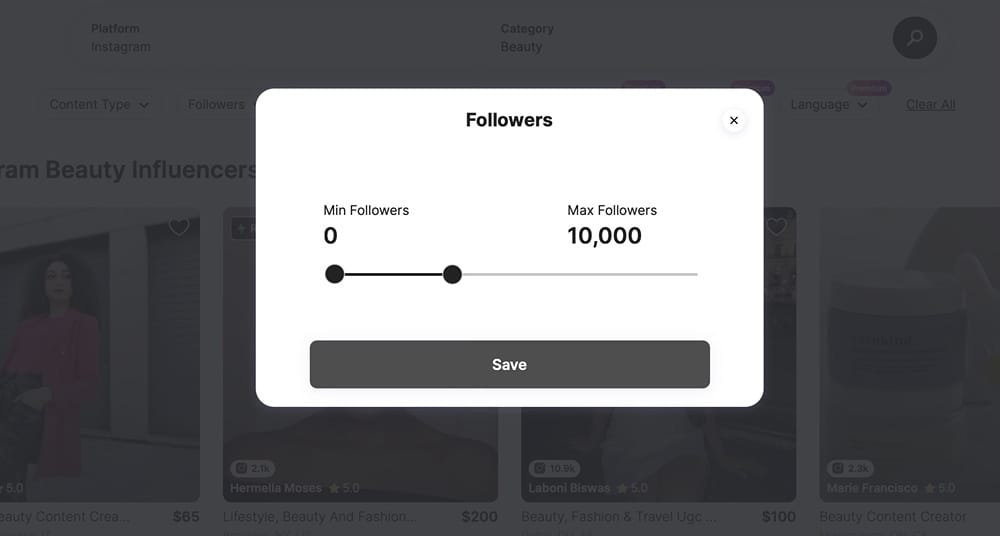
We at AI Video Cut do it too and ask for permission to use influencers' videos on social media channels, giving them the full credit.
#4. Feature Customers on Your Channels
Recognition is a powerful motivator. When customers see that their videos are being reposted by a brand, it validates their effort and encourages others to share too. Featuring customer videos on a company’s main Instagram grid, TikTok account, or YouTube Shorts playlist creates a feedback loop: the more people see their peers being highlighted, the more they want to join in.
#5. Ask for Testimonials
Sometimes, the simplest approach works best. Asking directly for testimonials like “Show us how you use this” or “Tell us what you think in a quick video” can yield a surprising volume of UGC. Customers who already like the product are often happy to record a short clip if prompted.
These testimonial videos can then be edited into ads, website content, or social media posts. With tools like AI Video Cut, these longer testimonials can be broken down into short, punchy clips perfect for TikTok or Instagram.
#6. Use UGC Marketplaces
In addition to influencer marketing software, there are now tools that allow you to find creators who would do UGC for you. For a certain fee, of course. The rates might ranges from $150 to $300 per video, depending on the creator.
4K Download, video and audio downloading software, uses one of those marketplaces (like Billo or Collabstr) to create UGC-like content for their TikTok page and thus stimulates real customers to do the same.
@4kdownloadapp 10 vids locked in before takeoff = full binge mode ✈️ Try 4K Downloader and secure your in-flight entertainment! #videodownload #videotools #4kdownload #videotools #savevideo ♬ original sound - 4K Download 🤟💙
How to Repurpose UGC on Your Own Social Media
A single user video can live across multiple platforms, but it often needs adjustments. That’s where editing and repurposing come in.
- Long product reviews can be trimmed into short clips for TikTok or Instagram.
- A compilation of several customer videos can become a YouTube highlight reel.
- Snippets can be integrated into paid ad campaigns for added credibility.
This is where tools like AI Video Cut become invaluable. Instead of spending hours manually trimming and resizing, social media managers can quickly edit UGC into platform-ready formats. A three-minute testimonial can become a series of 15-second clips, each optimized for TikTok, Reels, and Shorts.
- Open AI Video Cut in your browser.
- Upload a video as a file or drop a YouTube link.
- Choose the prompt (i.e. the format of the video you’d like to turn your original video into).
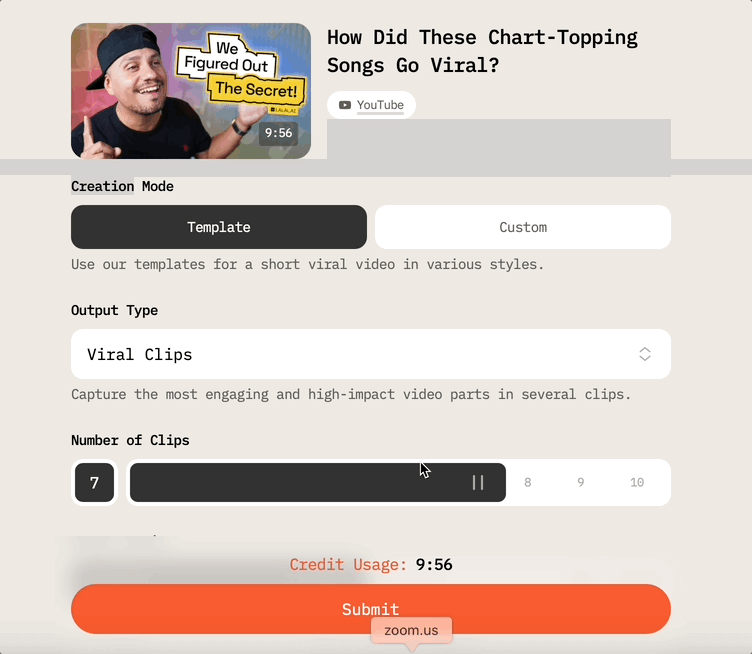
- Choose the clip length and number of videos you’d like to get as a result.
- Select the aspect ratio, language for captions, and captions style.
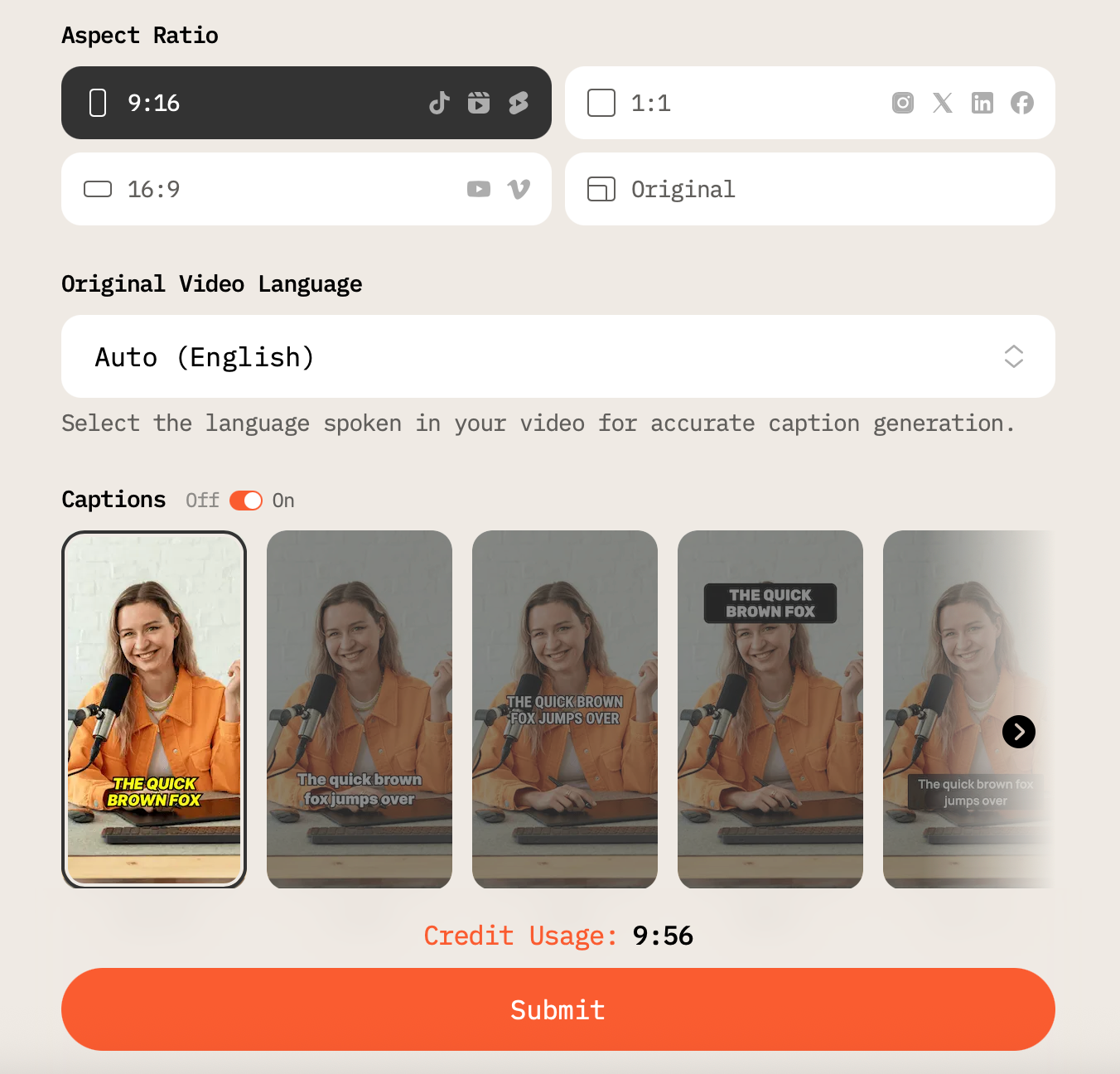
- Click Submit and let AI Video Cut process the video.
- Then, upload those videos on TikTok, Reels & Shorts, edit them in the convenient editor or Regenerate it.

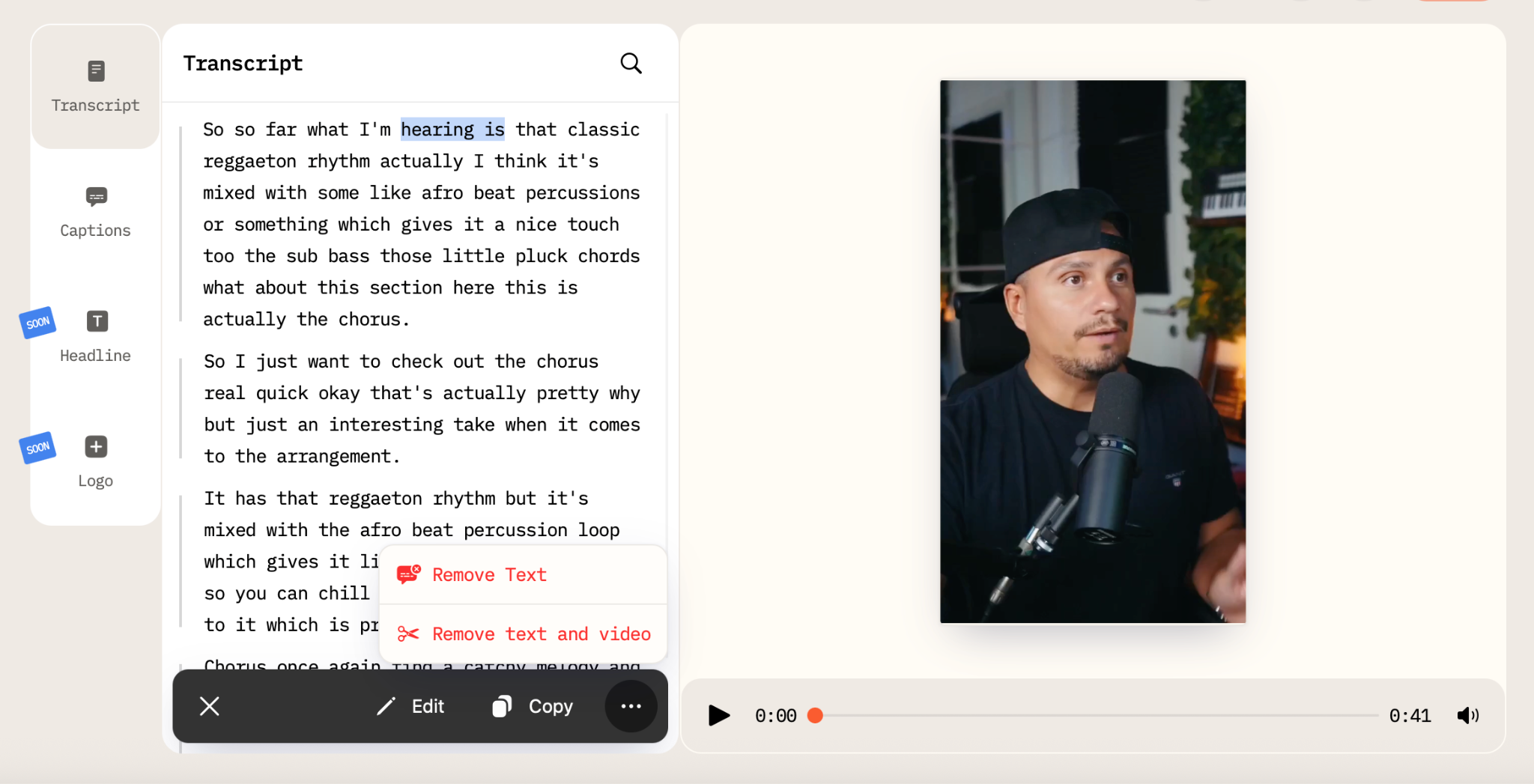
With the editor, you can change transcript, captions, remove only text from a transcript or text along with the bit of a video.
To streamline your struggles of coming up with a caption for the video, AI Video Cut automatically generated a video description with hashtags, which you can use on social media.
Legal and Ethical Considerations When Using UGC Videos
UGC may be casual, but businesses must handle it responsibly:
- Always ask before reposting customer videos.
- A simple tag or mention goes a long way.
- If UGC is sponsored or incentivized, disclose it clearly.
Failing to follow these basics can harm trust rather than build it.
How to Measure the Impact of UGC Video Content
To prove the value of UGC, businesses need to track its performance. And though it depends on your business and goals, key metrics include:
- Engagement (likes, comments, shares).
- Conversions or sales linked to UGC campaigns.
- Brand mentions and hashtag use.
- Growth in followers or community activity.
- Product and business metrics like revenue and higher retention rate.
For example, a clothing brand might track how many sales came directly after sharing a customer’s “outfit of the day” Reel and a B2B software company could measure how many leads were generated after posting a client testimonial video on LinkedIn. As long as you know how to track them.
The Bottom Line
UGC video isn’t just another marketing buzzword. It’s the modern equivalent of word-of-mouth, amplified by social media platforms where authenticity beats production value. For businesses and social media managers, learning how to encourage, curate, and repurpose UGC is no longer optional — it’s part of staying visible.
The good news is that creating an effective UGC strategy doesn’t have to mean long editing hours. Tools like AI Video Cut make it easier to take what your customers are already sharing and turn it into content that drives reach, engagement, and loyalty.
Frequently Asked Questions on UGC
Is UGC Content Paid?
Good question! The answer is that UGC content can be both unpaid and paid, depending on the situation.
Unpaid UGC is the “classic” form of UGC when customers or fans voluntarily create content because they like a product or want to share their experience.
But many businesses now commission UGC creators to produce authentic-looking videos that mimic organic customer content. Unlike influencers, these creators don’t always post on their own channels, the brand uses the videos for ads, social media, or websites.
For instance, a skincare company hires a freelancer to film a “before-and-after” video using their product. The brand pays the creator but markets the video as relatable customer-style content.
What Are the Risks of Using UGC?
The biggest concern is around permissions. Just because a video is publicly available doesn’t mean a brand has the right to use it in ads or marketing materials. Failing to get consent from the creator can lead to legal issues or, at the very least, damage to the brand’s reputation.
Another risk lies in authenticity. If UGC feels staged or if audiences discover that a supposedly organic video was actually paid for without proper disclosure, trust in the brand can erode quickly.
Can UGC Be Negative?
There’s the issue of quality control. Not all UGC reflects a brand in the best light. A customer might upload a video that shows the product but also includes inaccuracies (like mispronounced naming), off-brand messaging, or even inappropriate elements in the background. Brands need to curate carefully rather than reposting everything with their name attached.
So relying too heavily on UGC can backfire if it leads to inconsistent messaging. While the raw, unpolished nature of UGC is part of its appeal, you, as a business, still need to make sure it aligns with their broader brand voice and values.
